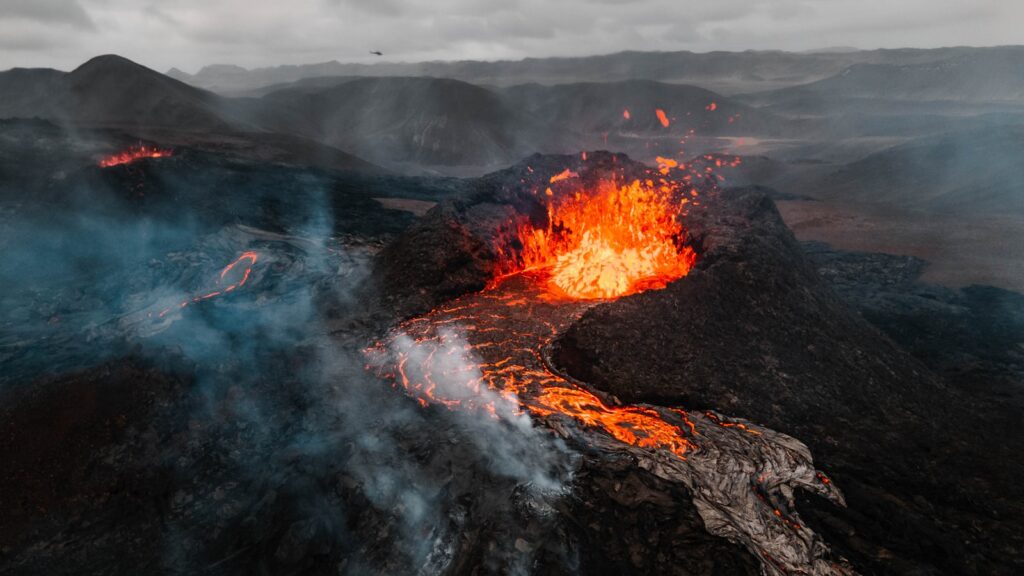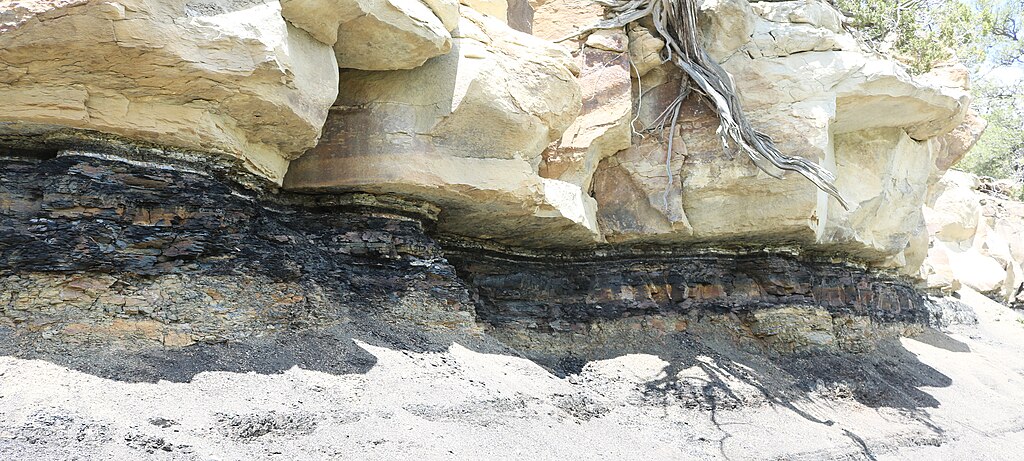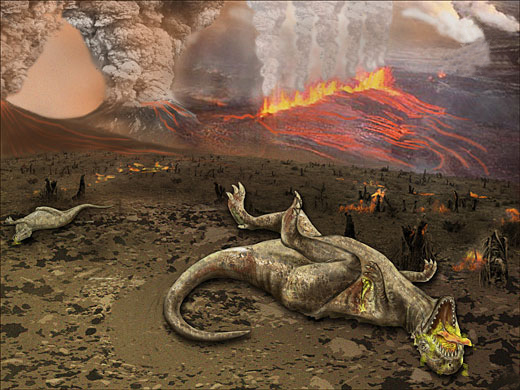The Cretaceous-Paleogene (K-Pg) extinction event represents one of the most catastrophic moments in Earth’s history, when approximately 75% of all species vanished in a geological instant. This mass extinction, which occurred 66 million years ago, marks the boundary between the Mesozoic and Cenozoic eras and dramatically altered the course of evolution on our planet. Most famously, this event brought an end to the 165-million-year reign of non-avian dinosaurs, clearing ecological niches that eventually allowed mammals to diversify and thrive. The K-Pg extinction (formerly known as the K-T or Cretaceous-Tertiary extinction) stands as a pivotal moment that demonstrates how suddenly and completely Earth’s biodiversity can be transformed by catastrophic events.
The Timing and Boundary of the K-Pg Extinction

The Cretaceous-Paleogene extinction event occurred precisely 66 million years ago, marking a clear stratigraphic boundary that geologists can identify worldwide. This boundary is characterized by a thin layer of sediment containing unusually high levels of the element iridium, which is rare in Earth’s crust but common in asteroids and comets. The timing of this event coincides with the end of the Cretaceous period (the final period of the Mesozoic Era) and the beginning of the Paleogene period (the first period of the Cenozoic Era). Scientists have dated this boundary with remarkable precision using radiometric dating techniques, particularly uranium-lead and argon-argon dating methods applied to volcanic ash layers found near the boundary. This precise dating has been crucial in correlating the extinction with the Chicxulub impact in Mexico’s Yucatán Peninsula.
The Asteroid Impact Theory

In 1980, physicist Luis Alvarez, his geologist son Walter, and scientists Frank Asaro and Helen Michel published a groundbreaking paper proposing that an asteroid impact caused the K-Pg extinction. Their evidence centered on the anomalous iridium layer found at the K-Pg boundary worldwide, as iridium is rare in Earth’s crust but abundant in asteroids. The discovery of the 180-kilometer Chicxulub crater in Mexico’s Yucatán Peninsula in the early 1990s provided compelling physical evidence for this theory. Scientists estimate the asteroid was approximately 10-15 kilometers in diameter and struck Earth with an energy equivalent to billions of Hiroshima bombs. The impact would have created a massive fireball, sent trillions of tons of debris into the atmosphere, generated worldwide wildfires, and triggered enormous tsunamis across the Gulf of Mexico. This theory is now widely accepted as the primary cause of the K-Pg extinction event.
Immediate Environmental Effects

The asteroid impact triggered a cascade of devastating environmental consequences that transformed Earth’s surface almost instantly. Upon impact, the asteroid vaporized, sending a superheated plume of material into and above the atmosphere, while causing earthquakes far beyond the magnitude of any recorded in human history. Thermal radiation from ejected material falling back to Earth likely ignited global wildfires, consuming forests worldwide. The impact generated tsunamis over 100 meters high that devastated coastal regions thousands of kilometers from the impact site. Perhaps most significantly, the atmosphere became choked with dust, sulfate aerosols, and soot that blocked sunlight for months or years, creating what scientists call an “impact winter.” This dramatic cooling and darkness severely inhibited photosynthesis, causing the collapse of food webs in both terrestrial and marine ecosystems.
Deccan Traps Volcanic Activity

While the asteroid impact theory dominates discussions of the K-Pg extinction, some scientists argue that massive volcanic eruptions in what is now India played an important contributing role. These eruptions, known as the Deccan Traps, began before the asteroid impact and continued for nearly a million years, covering over 500,000 square kilometers of land with lava flows up to 2 kilometers thick. The Deccan Traps released enormous quantities of carbon dioxide, sulfur dioxide, and other gases that would have caused significant climate disruption, including global warming from greenhouse gases and cooling from sulfate aerosols. Recent precise dating shows that the most intense volcanic activity coincided closely with the timing of the extinction event, suggesting a possible one-two punch of volcanic stress followed by asteroid impact. Some researchers propose that the impact may have even intensified the volcanic activity through seismic disturbances, though this remains controversial.
Marine Ecosystem Collapse

The oceans experienced catastrophic disruptions during the K-Pg extinction, with approximately 75% of marine species vanishing. Particularly hard-hit were groups that formed the basis of marine food webs, including phytoplankton like coccolithophores and foraminifera, whose calcium carbonate shells were vulnerable to the ocean acidification that likely followed the impact. Large marine reptiles like mosasaurs, plesiosaurs, and marine turtles disappeared completely, as did the distinctive ammonites, distant relatives of modern squids and octopuses that had thrived for over 300 million years. The extinction patterns in marine ecosystems show a correlation with calcium metabolism, suggesting that ocean acidification from impact-generated sulfuric and nitric acids played a major role. Deep ocean organisms fared somewhat better than those in surface waters, likely because deep-sea food webs rely more on detritus falling from above rather than on direct photosynthesis, offering a buffer against the immediate effects of the extinction.
The Fate of the Dinosaurs

The K-Pg extinction event is perhaps most famous for bringing an end to the dominance of non-avian dinosaurs, which had ruled Earth’s terrestrial ecosystems for 165 million years. All dinosaur groups except for a small clade of birds perished, including the mighty Tyrannosaurus rex, the three-horned Triceratops, and the duck-billed hadrosaurs that were flourishing right up until the extinction boundary. The abruptness of their disappearance is evidenced by the absence of dinosaur fossils above the K-Pg boundary layer, except for a few controversial specimens that might represent reworked material. Scientists believe most dinosaurs would have been particularly vulnerable to the extended period of darkness and cold following the impact, as many were large-bodied animals requiring substantial food intake. Birds, the only surviving dinosaur lineage, likely survived due to their small body size, dietary flexibility, and possibly their ability to eat seeds that could have served as a food stockpile during the environmental crisis.
Plant Life and Forest Recovery

The asteroid impact had profound effects on terrestrial plant communities, with evidence of widespread forest destruction followed by a distinctive “fern spike” in the fossil record. This pattern suggests an initial devastation of forests through wildfires and environmental stress, followed by colonization of the disturbed landscape by ferns, which are typically the first to recover after ecological disturbances. Pollen and spore records show a dramatic decline in plant diversity, with many flowering plant families disappearing or experiencing significant reductions. The recovery of diverse forest ecosystems took hundreds of thousands of years, with different regions showing varying patterns of reforestation. Fossil evidence indicates that the structure of post-extinction forests differed from Cretaceous forests, with different dominant species and potentially different canopy structures. The selective pressure of the extinction may have favored plants with adaptations like robust seed banks or efficient recolonization strategies.
The Survival of Mammals

While many mammal species perished during the K-Pg extinction, enough survived to eventually diversify into the myriad forms we see today. Most mammals that survived the extinction were small, primarily nocturnal creatures weighing less than a kilogram, with generalist feeding habits that allowed them to subsist on a variety of food sources during the environmental crisis. These attributes likely provided crucial advantages during the period of darkness and reduced plant productivity following the impact. Fossil evidence suggests that some mammals may have been able to enter torpor or hibernation states to conserve energy during food shortages. The removal of dinosaur competitors opened numerous ecological niches, allowing the relatively rapid diversification of mammals in the early Paleogene. Within just 10 million years after the extinction—a short time in evolutionary terms—mammals had evolved into many new forms, including the ancestors of primates, hoofed mammals, and cetaceans.
Survival Strategies and Selectivity

The K-Pg extinction wasn’t entirely random in determining which species survived and which perished. Scientists have identified several traits that correlate with survival across different animal groups. Freshwater species generally fared better than their marine or terrestrial counterparts, possibly because freshwater ecosystems are somewhat buffered against temperature fluctuations and can be supported by detritus-based food webs. Organisms capable of scavenging or consuming detritus had survival advantages when primary production collapsed. Animals with behavioral adaptations like burrowing, hibernation, or torpor could shelter from extreme conditions and reduce their energy needs during food shortages. Body size also played a critical role in survival—no terrestrial animal weighing more than about 25 kilograms appears to have survived, with smaller organisms having lower food requirements and possibly better ability to shelter from harsh conditions. These patterns of selectivity have helped scientists understand which traits might convey resilience during mass extinction events.
The Recovery Period

The recovery of Earth’s biodiversity following the K-Pg extinction proceeded through distinct phases over millions of years. The initial survival phase lasted perhaps decades or centuries, during which environmental conditions gradually normalized as dust settled from the atmosphere. This was followed by a recovery phase lasting tens of thousands of years, characterized by low-diversity ecosystems dominated by opportunistic “disaster species” like ferns on land and certain plankton in the oceans. The third phase, lasting several million years, saw rapid evolutionary innovation as surviving lineages adapted to fill vacant ecological niches, leading to an explosion of new species. Marine recovery appears to have proceeded from the deep ocean upward, with benthic (bottom-dwelling) ecosystems recovering more quickly than those in surface waters. On land, insect diversity recovered relatively quickly, while the development of complex forest ecosystems took considerably longer. Full recovery of biodiversity to pre-extinction levels is estimated to have taken 2-10 million years, depending on the ecosystem.
Scientific Debates and Continuing Research

Though the asteroid impact theory is widely accepted, vibrant scientific debates continue about various aspects of the K-Pg extinction. One ongoing discussion concerns the relative importance of the Chicxulub impact versus Deccan Traps volcanism, with some researchers advocating for a multiple-cause scenario. Another area of active research involves the precise killing mechanisms—whether darkness, cold, acid rain, ocean acidification, or some combination was most responsible for biodiversity loss. Paleontologists continue to refine our understanding of extinction patterns, with new fossil discoveries sometimes challenging existing models of which groups were most affected. Advanced analytical techniques like stable isotope analysis of fossils provide new insights into ecosystem collapse and recovery. Research at the Chicxulub crater itself continues through scientific drilling projects, which have revealed details about the impact processes and immediate aftermath. These ongoing investigations demonstrate how the K-Pg extinction continues to be a dynamic area of scientific inquiry.
Lessons for Modern Biodiversity

The K-Pg extinction event offers sobering lessons for understanding modern biodiversity crises. While today’s species losses stem from human activities rather than asteroid impacts, some parallels exist in how ecosystems respond to rapid environmental change. The K-Pg event demonstrates that even groups that have dominated for millions of years, like non-avian dinosaurs, can disappear when environmental conditions change drastically enough. The selective nature of the extinction—favoring small, adaptable generalists over large specialists—may have analogues in current extinction patterns, where specialized species often face greater threats. Perhaps most importantly, the K-Pg extinction reveals that while life ultimately recovers from mass extinctions, this recovery takes hundreds of thousands to millions of years—far beyond human timescales. This perspective underscores the essentially permanent nature of anthropogenic biodiversity loss on any timeframe relevant to human civilization, emphasizing the importance of conservation efforts.
The K-Pg Boundary in the Fossil Record

The physical evidence of the K-Pg extinction is preserved as a distinctive boundary layer in sedimentary rocks worldwide. This layer, typically only a few centimeters thick, contains several telltale markers of the catastrophic event, including the iridium anomaly that first suggested an extraterrestrial impact. In marine settings, the boundary frequently shows a sudden disappearance of Cretaceous microfossils, followed by an interval with very few fossils, and then the appearance of Paleogene species. Close to the impact site in the Gulf of Mexico region, the boundary contains shocked quartz, tiny spherules of melted and recondensed rock, and other impact-related debris. In terrestrial settings, particularly in western North America, the boundary often coincides with a layer of coal or carbonaceous shale containing fossilized fern spores, representing the “fern spike” that followed forest destruction. Paleontologists continue to discover new K-Pg boundary sites, each adding details to our understanding of how the extinction affected different regions and ecosystems.
The Dawn of the Age of Mammals

The aftermath of the K-Pg extinction event set the stage for the rise of mammals as the dominant large land animals, fundamentally reshaping Earth’s ecosystems into forms more familiar to us today. While the Mesozoic is often called the “Age of Reptiles,” the Cenozoic era that followed the extinction is frequently termed the “Age of Mammals.” Within the first few million years after the extinction, mammals began an extraordinary adaptive radiation, evolving into forms as diverse as early primates, primitive hoofed mammals, and the ancestors of modern carnivores. By 10 million years after the extinction, recognizable representatives of most modern mammal orders had appeared. The early Cenozoic also saw the rise of large flightless birds as apex predators in some ecosystems, filling niches vacated by predatory dinosaurs. Flowering plants similarly diversified, establishing the coevolutionary relationships with pollinators that characterize modern terrestrial ecosystems. This transformation represents one of the most significant ecological shifts in Earth’s history, demonstrating how catastrophic events can redirect evolutionary trajectories.
Conclusion: A Pivotal Moment in Earth’s History

The Cretaceous-Paleogene extinction event stands as a profound reminder of life’s fragility and resilience in the face of catastrophic change. In a geological instant, an asteroid impact and possibly volcanic activity transformed Earth’s biosphere, eliminating species that had thrived for millions of years and redirecting evolution toward the modern world we recognize today. Without this extinction, mammals might never have evolved beyond small nocturnal creatures, and humans might never have existed. The K-Pg event demonstrates that evolution is not merely a story of gradual adaptation but is also shaped by rare, extreme events that can suddenly rewrite the rules of survival. As we face modern environmental challenges, the K-Pg extinction offers both a warning about the vulnerability of even long-successful species and hope in the knowledge that life, in some form, has persisted through even the most catastrophic global changes. This defining moment in Earth’s history continues to fascinate scientists and the public alike, embodying both the destructive and creative aspects of our planet’s dynamic systems.



